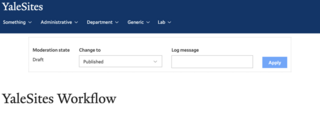Boost your team collaboration using the YaleSites platform. We’re thrilled to introduce substantial improvements to our platform, aimed at making content creation more efficient and collaborative. We have implemented an editorial workflow to regulate content creation, management, and publishing, guaranteeing a seamless and productive process. These enhancements aim to simplify your content management approach and foster effective teamwork within your organization.
New User Roles
Our platform now incorporates two new user roles: Contributor and Editor. These roles are designed to distribute the responsibilities of content creation and management among your team more effectively.
The Contributor role is designed for users responsible for creating and editing content. However, contributors cannot publish pages. When a contributor edits published content, an unpublished draft is created that must be approved and published by an Editor or site admin. The Editor role has all the permissions of the Contributor and the power to review, approve, and publish content.
